Studley Royal Park including the ruins of Fountains Abbey: Fountains Abbey was one of the wealthiest monasteries of England. The abbey was founded in 1132 and it existed for over 400 years, until the Dissolution of the Monasteries by King Henry VIII of England in 1539. Today, Fountains Abbey is the largest monastic ruin in Great Britain. The abbey is also one of the best preserved monastic ruins in Great Britain. The Fountains Abbey watermill is over 800 years old and the only Cistercian cornmill left in Britain. Fountains Hall is an Elizabethan mansion on the grounds of Studley Royal Park, which also includes the ruins of Fountains Abbey. Fountains Hall was built in the period 1598-1604, partly with the stones of the abbey ruins. A Georgian water garden was created around the ruins of Fountains Abbey in 1720. Studley Royal Park contains canals, ponds, cascades, temples and a tinyBanqueting House in the Palladian style. Studley Royal Park is situated close to Ripon in North Yorkshire, about 50 km from the UNESCO World Heritage Saltaire. Studley Royal Park is one of the best surviving examples of a Georgian water garden in England. Studley Royal Park including the ruins of Fountains Abbey was declared a UNESCO World Heritage in 1986.
www.werelderfgoedfotos.nl © Copyright World Heritage Photos
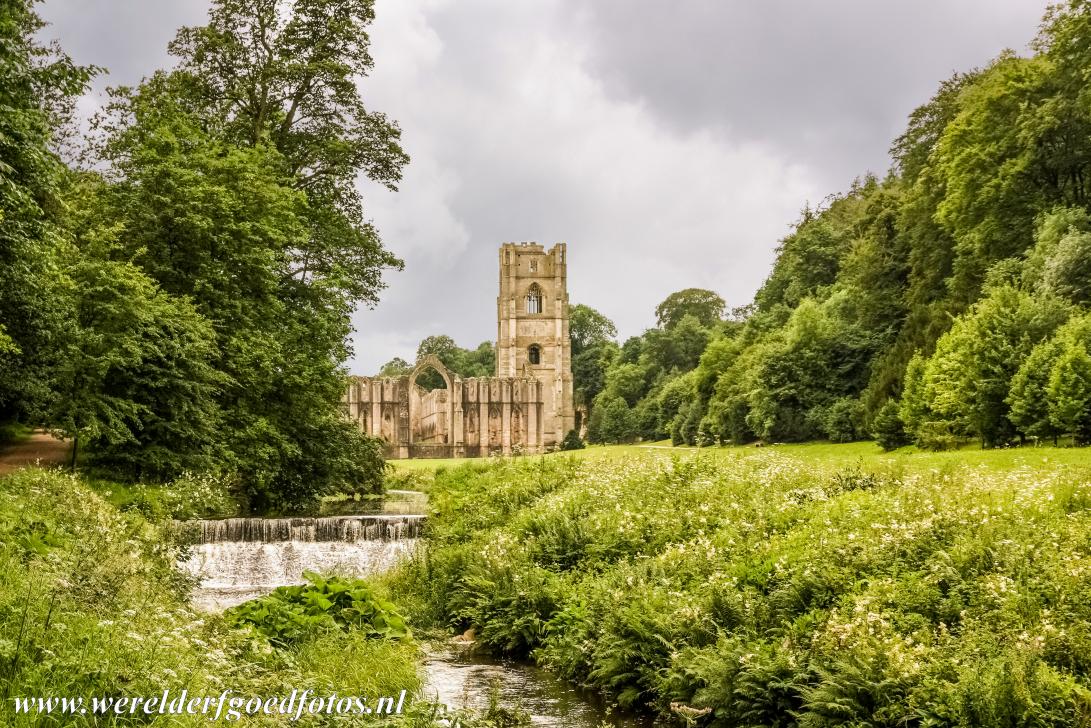
Studley Royal Park including the ruins of Fountains Abbey: The Grey's Walk leading to the ruins of Fountains Abbey, situated in Studley Royal Park. A Georgian water garden created around the ruins of Fountains Abbey in 1720. Fountains Abbey is the largest monastic ruin in Great Britain. Studley Royal Park including the ruins of Fountains Abbey is a UNESCO World Heritage.

Studley Royal Park including the ruins of Fountains Abbey: The Grey's Walk leading to the ruins of Fountains Abbey, situated in Studley Royal Park. A Georgian water garden created around the ruins of Fountains Abbey in 1720. Fountains Abbey is the largest monastic ruin in Great Britain. Studley Royal Park including the ruins of Fountains Abbey is a UNESCO World Heritage.
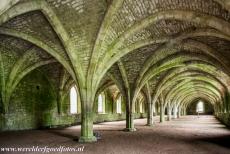
Studley Royal Park including the ruins of Fountains Abbey: The cellarium of the abbey was used to store food, ale and wines. A river is running underneath the cellarium. Fountains Abbey was one of the richest monasteries of England until the Dissolution of the Monasteries by Henry VIII in 1539. The imposing vaulted ceiling of the cellarium has remained completely intact.
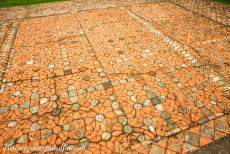
Studley Royal Park including the ruins of Fountains Abbey: The 13th century ceramic floor tiles of the abbey. These decorative tiles are the last remaining floor tiles inside the abbey. The ruins of Fountains Abbey are the best preserved ruins of a Cistercian monastery in Britain. Fountains Abbey was dissolved by King Henry VIII of England in 1539, all the monks were sent away.
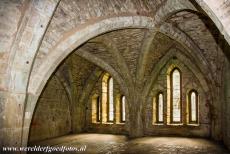
Studley Royal Park including the ruins of Fountains Abbey: The muniments room of the abbey is situated above the warming room, called the calefactorium. The monks kept their documents in the muniments room where they stayed dry in all seasons. In medieval times, the calefactorium was one of the few heated rooms in the abbey.
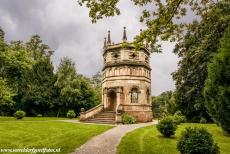
Studley Royal Park including the ruins of Fountains Abbey: The Octagon Tower was built in 1738. The Octagonal Tower is a tiny ornamental building in the neo-Gothic style, it is located along the High Ride path near the Serpentine Tunnel, a winding and completely dark tunnel between the High Ride path and the Temple of Piety. Studley Royal Park and the ruins of Fountains Abbey are located close to Ripon in North Yorkshire, England.
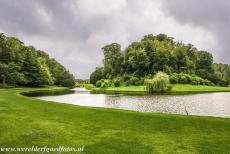
Studley Royal Park including the ruins of Fountains Abbey: Fountains Hall is a large Elizabethan mansion on the grounds of Studley Royal Park. Fountains Hall was built in the Jacobean style in the period 1598-1604, partly with the stones of Fountains Abbey. The woods and valleys around the ruins of the abbey were transformed into a Georgian water garden in 1720.
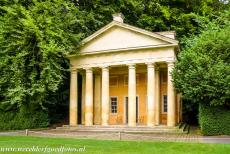
Studley Royal Park including the ruins of Fountains Abbey: The Temple of Piety is probably one of the most famous follies in Studley Royal Park. The temple was built the Neoclassical style in 1729-1730. The Temple of Piety is overlooking Moon Pond. Studley Royal Park is one of the best surviving examples of a Georgian water garden in England.
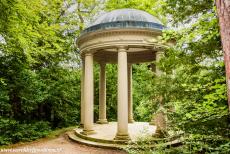
Studley Royal Park including the ruins of Fountains Abbey: The Temple of Fame is situated along the High Ride path in Studley Royal Park. The temple is a small rotunda built in 1770. The park is also home to a great variety of ancient trees, numerous trees are over 300 years old. A lime tree avenue leads through the Deer Park to the original entrance gate of the estate.
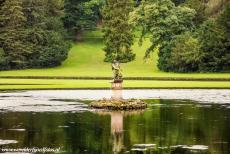
Studley Royal Park including the ruins of Fountains Abbey: The statue of Neptune reflected in the water of the Moon Pond, there are several ponds in Studley Royal Park, among them Moon Pond and Half Moon Pond. The park is home to a wealth of flora and fauna. The medieval Deer Park is home to over 500 wild deer such as red deer, fallow deer and sika deer, an Asian species.
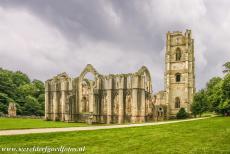
Fountains Abbey is one of the largest monastic ruins in Britain. The abbey was founded in 1132. The ruins of Fountains Abbey are largely of the Romanesque period, the church tower and some other parts were built later. The Studley Royal Park including the ruins of Fountains Abbey were inscribed on the UNESCO World Heritage List in 1986.
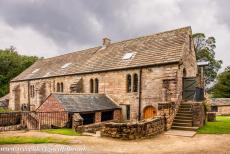
Fountains Mill is the oldest building of Studley Royal Park. The watermill is 800 years old and the only Cistercian cornmill left in Britain. The mill is largely of the Romanesque period, some parts are earlier. The mill was built in the 12th century by the monks to grind grain for the abbey. The mill survived the closure of the abbey, it was in continuous use until 1927. Fountains Mill is part of the UNESCO World Heritage: Studley Royal Park including the ruins of Fountains Abbey.
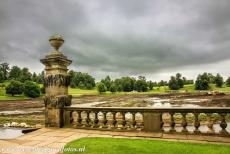
Studley Royal Park including the ruins of Fountains Abbey: Major restoration works of Studley Lake. The Georgian water gardens around the ruins of Fountains Abbey contain lakes, cascade waterfalls, ponds, canals and ornamental buildings, among them elegant small temples and the Banqueting House in the Palladian style. Studley Royal House was a medieval manor house, the house was destroyed by fire in 1946, only the stables survived.
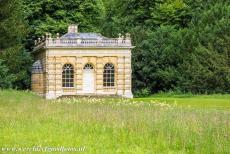
Studley Royal Park including the ruins of Fountains Abbey: The tiny Banqueting House was built in the Palladian style from 1728 to 1732, it has only one storey and two rooms. The Banqueting House was originally built as an orangery, but was later used for dinner parties, the building is situated in Studley Royal Park near the ruins of Fountains Abbey. Studley Royal Park is situated close to the market town of Ripon in North Yorkshire.
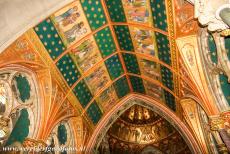
Studley Royal Park and the ruins of Fountains Abbey: St. Mary's Church is lavishly decorated. It houses a fine octagon-shaped font, made of marble and adorned with bronze figures. St. Mary's Church was built in memory of Frederick Vyner who was killed in Greece in 1870. The church is part of the UNESCO World Heritage: Studley Royal Park including the ruins of Fountains Abbey.
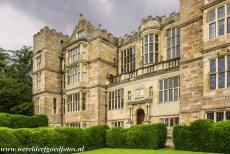
Fountains Hall is a 17th century Elizabethan mansion on the grounds of Studley Royal Park. Two rooms are open to visitors. During the Second World War, the Vyners lost a son and daughter, a stained-glass window, a stone cross and two statues were created to remember them, the Vyner Memorial is situated in the monumental staircase of Fountains Hall. Fountains Hall is part of the UNESCO World Heritage: Studley Royal Park including the ruins of Fountains Abbey.
